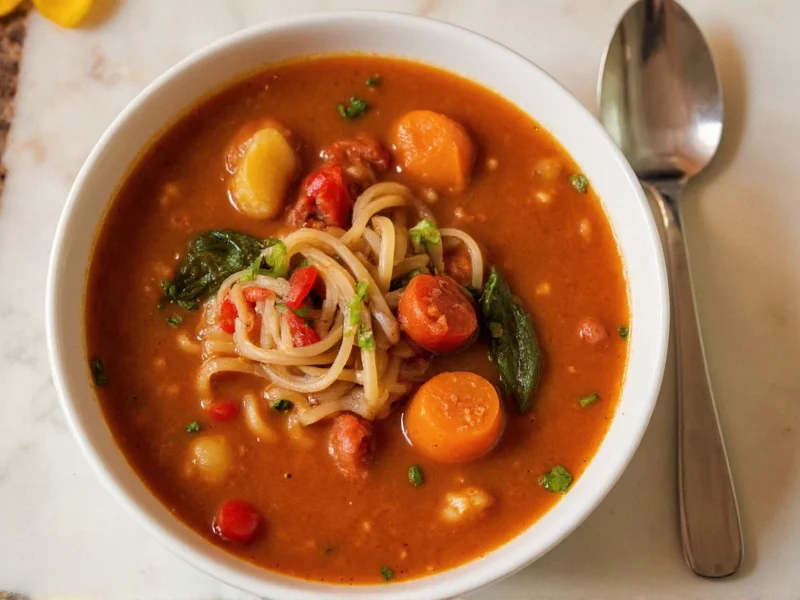For decades, Olive Garden's minestrone soup has been a beloved menu staple that consistently ranks among the restaurant's most popular appetizers. Understanding exactly what goes into this flavorful Italian classic helps diners make informed choices whether they're dining in, ordering takeout, or attempting to recreate the dish at home.
What Makes Olive Garden Minestrone Soup Unique
Unlike traditional minestrone recipes that vary by region in Italy, Olive Garden maintains a consistent recipe across all locations. The restaurant's version stands out for its balanced vegetable-to-broth ratio and distinctive herb profile. While authentic Italian minestrone often includes rice or barley, Olive Garden's recipe features small pasta shapes that hold their texture well even when the soup sits for a short time.
Detailed Ingredient Analysis
Olive Garden's minestrone soup contains a carefully selected combination of fresh and canned ingredients that create its signature taste:
| Ingredient Category | Specific Components | Notes |
|---|---|---|
| Vegetables | Tomatoes, onions, carrots, celery, cabbage, zucchini, green beans, potatoes | Fresh vegetables form the soup's foundation |
| Beans | Cannellini beans, kidney beans | Provide protein and texture |
| Pasta | Small pasta shapes | Typically ditalini or similar small tube pasta |
| Seasonings | Extra virgin olive oil, basil, oregano, garlic, salt, pepper | Signature herb blend creates distinctive flavor |
| Liquid Base | Tomato broth | Rich tomato foundation without meat stock |
Nutritional Profile and Dietary Information
According to Olive Garden's published nutritional information, a standard cup (8 fl oz) serving of minestrone soup contains approximately:
- Calories: 110
- Total Fat: 3.5g
- Saturated Fat: 0.5g
- Cholesterol: 0mg
- Sodium: 960mg
- Total Carbohydrates: 18g
- Dietary Fiber: 4g
- Sugars: 4g
- Protein: 4g
The soup qualifies as vegetarian and contains no animal products in its standard preparation. However, customers with specific dietary restrictions should note that Olive Garden prepares all menu items in shared kitchen spaces, which may result in cross-contamination with allergens.
How Olive Garden Serves Minestrone Soup
At Olive Garden restaurants, minestrone soup appears on the menu as part of their famous "Never Ending Pasta Bowl" promotion and as a standalone appetizer. The soup typically arrives in a wide-rimmed bowl with a side of freshly baked breadsticks. Many locations offer the soup with a sprinkle of freshly grated Parmesan cheese on top, though this comes at an additional charge.
Creating an Olive Garden Minestrone Soup Copycat Recipe
While Olive Garden keeps its exact recipe proprietary, home cooks have developed remarkably accurate approximations. This copycat olive garden minestrone soup recipe captures the essence of the restaurant version:
Homemade Olive Garden Minestrone Soup Recipe
Makes 6 servings | Preparation: 20 minutes | Cooking: 40 minutes
Ingredients
- 2 tablespoons extra virgin olive oil
- 1 medium onion, diced
- 2 carrots, peeled and diced
- 2 celery stalks, diced
- 3 garlic cloves, minced
- 1 (28-ounce) can crushed tomatoes
- 4 cups vegetable broth
- 1 small head cabbage, cored and thinly sliced
- 1 medium zucchini, diced
- 1 cup green beans, trimmed and cut into 1-inch pieces
- 1 medium potato, peeled and diced
- 1 (15-ounce) can cannellini beans, drained and rinsed
- 1 (15-ounce) can kidney beans, drained and rinsed
- ½ cup small pasta (ditalini or elbow macaroni)
- 1 teaspoon dried basil
- 1 teaspoon dried oregano
- Salt and freshly ground black pepper to taste
- Fresh parsley for garnish
Instructions
- Heat olive oil in a large pot over medium heat. Add onion, carrots, and celery. Cook until vegetables soften, about 5-7 minutes.
- Add garlic and cook for 1 minute until fragrant.
- Pour in crushed tomatoes and vegetable broth. Bring to a simmer.
- Add cabbage, zucchini, green beans, and potato. Simmer for 15 minutes.
- Stir in both types of beans, pasta, basil, and oregano. Continue simmering until pasta is tender, about 10-12 minutes.
- Season with salt and pepper to taste.
- Serve hot with fresh parsley garnish and crusty bread on the side.
Seasonal Variations and Regional Differences
While Olive Garden maintains recipe consistency across locations, minor variations may occur based on seasonal vegetable availability. Some regions might feature slightly different vegetable proportions based on local preferences. The restaurant occasionally introduces limited-time variations during special promotions, but the core recipe remains unchanged.
Why Olive Garden's Minestrone Soup Appeals to So Many Diners
The enduring popularity of olive garden minestrone soup vegetarian option stems from its balanced flavor profile that satisfies multiple taste preferences. The soup delivers savory depth from the vegetable broth, subtle sweetness from the tomatoes, and earthy notes from the herb blend. Its hearty vegetable content makes it satisfying without being heavy, while the moderate sodium level enhances flavor without overwhelming the palate.











 浙公网安备
33010002000092号
浙公网安备
33010002000092号 浙B2-20120091-4
浙B2-20120091-4